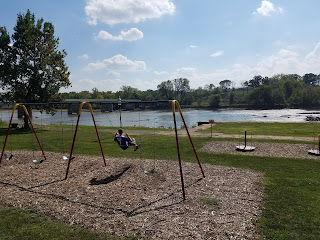We departed Nauvoo to visit Carthage, Illinois. The Church has built a beautiful visitors' center and meeting location at the site. Tours are held regularly. I learned still more information that I probably had heard before. We toured the actual jail cell and then went upstairs to the location of the martyrdom.
To sit in that room and imagine the commotion was overwhelming. The missionaries played a reenactment on a speaker so we could feel like we were there. We could feel the bullet holes in the door.
We drove away toward Iowa, with the purpose to stop at every historical marker along the way. The first stop was Bonaparte, Iowa.
We got out and read every single marker for two days.
On April 24, 1846, emigrants under the direction of Brigham
Young established a way station halfway into their trek across Iowa. This
semi-permanent settlement was named Garden Grove because the entire grove was
covered with wild onions as far as the eye could see. Within three weeks of
their arrival, the pioneers enclosed and planted 715 acres. They founded the
village to assist those who did not have sufficient means to continue their
journey, as well as to support and supply future companies of pioneers.

Mount Pisgah was a semi-permanent settlement or way station
from 1846 to 1852 along the Mormon Trail between Garden Grove and Council
Bluffs, in the state of Iowa.
Mormon Trail Lake east of Bridgewater.
They blazed the “Mormon Trail” west, converging at Old Town
and crossing the West Nishnabotna River at a limestone rock bottom trail
crossing. That crossing later became the site of Old Macedonia. The Mormons
continued west to the Grand Encampment on the east side of the Missouri River
in Iowa and Winter Quarters in Nebraska.











No comments:
Post a Comment